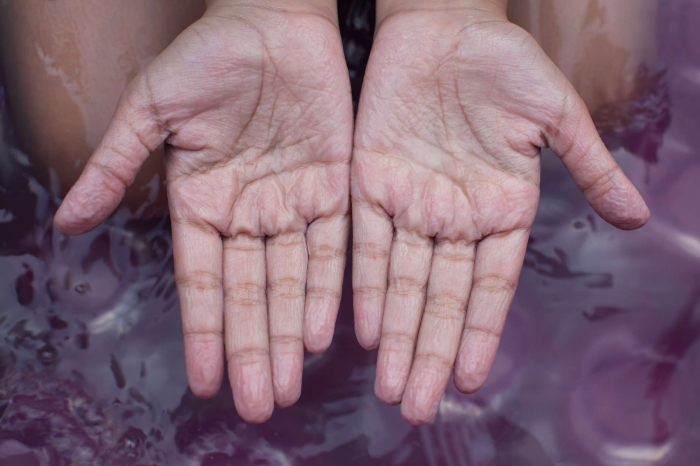The skin on our fingertips and toes shrivels like prunes when soaked for a few minutes in water. But is this an adaptation that occurred to help us in our evolutionary past? And what can it reveal about your health today?
Spend more than a few minutes soaking in a bath or paddling around a swimming pool and your fingers will undergo a dramatic transformation. Where there were once delicate whorls of lightly ridged epidermis, engorged folds of ugly pruned skin will now be found.
This striking change is familiar yet also baffling. Only the skin on our fingers and toes wrinkle when immersed in water, while other body parts such as our forearms, torso, legs and face remain no more crinkled than before they were submerged.
This water-induced wrinkling of skin on our fingertips and toes has occupied the thoughts and work of scientists for decades. Most have puzzled over what causes this puckering in the first place, but more recently the question of why, and what purpose it may serve, has attracted the attention of researchers. Perhaps more intriguing still, however, is what our shriveled fingers can reveal about our own health.
It takes around 3.5 minutes in warm water – 40C (104F) is considered the optimal temperature – for your fingertips to begin wrinkling, while in cooler temperatures of about 20C (68F) it can take up to 10 minutes. Most studies have found it takes around 30 minutes of soaking time to reach maximum wrinklage, however.
Fingertip wrinkling was commonly thought to be a passive response where the upper layers of the skin swelled as water flooded into the cells via a process known as osmosis – where water molecules move across a membrane to equalise the concentration of the solutions on either side. But as long ago as 1935, scientists have suspected there is more to the process than this.
Doctors studying patients with injuries that had severed the median nerve – one of the main nerves that run down the arm to the hand – found that their fingers did not wrinkle. Among its many roles, the median nerve helps to control so-called sympathetic activities such as sweating and the constriction of blood vessels. Their discovery suggested that the water-induced wrinkling of fingertips was in fact controlled by the nervous system.
Later studies by doctors in the 1970s provided further evidence of this, and they proposed using the immersion of the hands in water as a simple bedside test to assess nerve damage that might affect the regulation of unconscious processes such as blood flow.
Then in 2003, neurologists Einar Wilder-Smith and Adeline Chow, who were working at the National University Hospital in Singapore at the time, took measurements of blood circulation in the hands of volunteers as they soaked them in water. They found that as the skin on the volunteers' fingertips began to wrinkle, there was a significant drop in blood flow in the fingers.
When they applied a local anesthetic cream that caused the blood vessels in the fingers of healthy volunteers to temporarily constrict, they found it produced similar levels of wrinkling as water immersion.
"It makes sense when you look at your fingers when they go wrinkly," says Nick Davis, a neuroscientist and psychologist at Manchester Metropolitan University, who has studied fingertip wrinkling. "The finger pads go pale and that is because the blood supply is being constricted away from the surface."
Wilder-Smith and his colleagues proposed that when our hands are immersed in water, the sweat ducts in our fingers open up to allow water in, which leads to an imbalance in the salts in our skin. This change in the salt balance triggers the firing of nerve fibres in the fingers, leading to the blood vessels around the sweat ducts to constrict. This in turn causes a loss of volume in the fleshy area of the fingertip, which pulls the overlying skin downwards so that it distorts into wrinkles. The pattern of the wrinkles depends on the way the outermost layer of skin – the epidermis – is anchored to the layers beneath it.
There have also been suggestions that the outer layers of skin may also swell a little to enhance the wrinkling. By osmosis alone, however, our skin would need to swell by 20% to achieve the wrinkles we see in our fingers, which would leave them hideously enlarged. But when the upper layers of skin swell slightly and the lower levels shrink at the same time, the wrinkling becomes pronounced far sooner, says Pablo Saez Viñas, a biomechanical engineer at the Technical University of Catalonia, who has used computer modelling to examine the mechanism.
"You need both to have normal levels of wrinkles," he says. "If you don't have that neurological response, which happens in some individuals, wrinkles are inhibited."
But if wrinkling is controlled by our nerves, it means our bodies are actively reacting to being in water. "That means it is happening for a reason," says Davis. "And that means it could be giving us an advantage."
It was a question from one of his children during a bath about why their fingers had gone wrinkly that recently led Davis to dig into what this advantage could be. With the help of 500 volunteers who visited the Science Museum in London during 2020, Davis measured how much force they needed to use to grip a plastic object. Perhaps unsurprisingly, those with dry, unwrinkled hands needed to use less force than people whose hands were wet – so their grip on the object was better. But when they submerged their hands in a water bath for a few minutes to turn their hands wrinkly, the grip force fell between the two even though their hands were still wet.
"The results were amazingly clear," says Davis. "The wrinkling increased the amount of friction between the fingers and the object. What is particularly interesting is that our fingers are sensitive to this change in the surface friction and we use this information to apply less force to grip an object securely."
The object that Davis' volunteers were gripping weighed less than a couple of coins, so the amount of grip required was small. But when performing more arduous tasks in a wet environment, this difference in friction could become more important.
"If you don't have to squeeze as hard to grip something, the muscles in your hands get less tired and so you can do it for longer," he says.
His findings match those by other researchers who have found that the wrinkling of our fingertips makes it easier for us to handle wet objects. In 2013, a team of neuroscientists at Newcastle University in the UK asked volunteers to transfer glass marbles of varying sizes and fishing weights from one container to another. In one case the objects were dry, and in the other they were at the bottom of a container filled with water. It took 17% longer for the participants to transfer the submerged objects with unwrinkled fingers than when they were dry. But when their fingers were wrinkled, they could transfer the submerged marbles and weights 12% quicker than when their fingers were wet and unwrinkled. Interestingly, there was no difference in transferring the dry objects with wrinkled or unwrinkled fingers.
Some scientists have suggested that the wrinkles on our fingertips and toes may act like rain treads on tyres or the soles of shoes. The channels produced by the wrinkles help to squeeze water away from the point of contact between the fingers and an object.
This suggests that humans may have evolved fingertip and toe wrinkling at some point in our past to help us grip wet objects and surfaces.
"Since it seems to give better grip under water, I would assume that it has to do with either locomotion in very wet conditions or potentially with manipulating objects under water," says Tom Smulders, an evolutionary neuroscientist at Newcastle University who led the 2013 study. It could have given our ancestors a key advantage when it came to walking over wet rocks or gripping branches, for example. Alternatively, it could have helped us when catching or foraging for food such as shellfish.
"The latter would imply it is unique to humans, whereas if it's the former, we would expect it to happen in other primates as well," says Smulders. Finger wrinkling has yet to be observed in our closest relatives in the primate world such as chimpanzees, but the fingers of Japanese macaque monkeys, which are known to bath for long periods in hot water, have been seen to also wrinkle after they have been submerged in water. But the lack of evidence in other primates does not mean it doesn't happen, it may simply be because no-one has looked closely enough yet, says Smulders. "We don't know the answer to this question yet."
There are some other interesting clues about when this adaptation may have appeared in our species. Fingertip wrinkling is less pronounced in saltwater and takes longer than it does in freshwater. This is probably because the salt gradient between the skin and surrounding environment is lower in saltwater, and so the salt imbalance that triggers the nerve fibres is less dramatic. So, it could be an adaptation that helped our ancestors live in freshwater environments rather than along coastlines.
But there are no firm answers, and some believe it could just be a coincidental physiological response with no adaptive function.
Strangely there are other baffling mysteries – women take longer to develop wrinkles than men do, for example. And why exactly does our skin return to its normal state – normally after 10-20 minutes – if there is no clear disadvantage to our grip on dry objects of having wrinkly fingertips? Surely if having wrinkly fingers can improve our grip in the wet, but not harm it when dry, why would our fingertips not be permanently wrinkly?
One reason for that could be the change in sensation the wrinkling also causes. Our fingertips are packed with nerves, and the pruning of our skin changes the way we feel things we touch (although one study has shown it does not affect our ability to discriminate between objects based on touch).
"Some people have a real aversion to it because picking something up with wrinkly fingers feels weird," says Davis. "It could be because the balance of skin receptors have changed position, but there could be a psychological dimension too. It would be fun to investigate why. There could be other things we can do less well with wrinkly fingers."
But the wrinkling of our fingers and toes in water can reveal key information about our health in surprising ways too. Wrinkles take longer to form in people with skin conditions like psoriasis and vitiligo, for example. Patients with cystic fibrosis experience excessive wrinkling of their palms as well as their fingers, and this has even been noticed in people who are genetic carriers of the disease. Patients suffering from type 2 diabetes also sometimes show markedly decreased levels of skin wrinkling when their hands are placed in water. Similarly reduced wrinkling has been seen in people who have suffered heart failure, perhaps due to some disruption in the control of their cardiovascular system.
Unsymmetrical wrinkling of the fingers – where one hand wrinkles less than the other despite the same immersion time – has even been suggested as an early sign of Parkinson's disease as it indicates the sympathetic nervous system is not functioning correctly on one side of the body.
So, while the question of why our fingers and toes began wrinkling in water in the first place remains open, our pruney digits are proving useful to doctors in other surprising ways.
BBC
More about:
















































